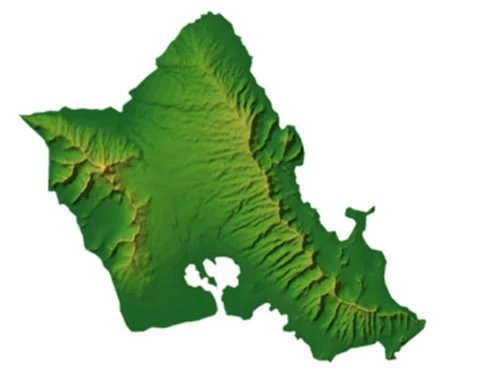Oahu Geography
Oahu's geography is shaped by two extinct volcanoes - the Wai'anae and Ko'olau mountain ranges - creating a diverse landscape of mountain ridges, coastal plains, and lush valleys. Mount Ka'ala, the island's tallest peak at 4,003 feet, crowns the drier west side, while the windward side remains green and rainy due to trade winds. With 227 miles of shoreline and a central plain dividing the ranges, Oahu's topography supports both urban centers and untouched wilderness.
Oahu is the third largest of the main Hawaiian islands (after Hawaii's Big Island and Maui) encompassing 596.7 square miles (1,545.4 km2). It measures 44 miles (71 km) from north to south and 30 miles (48 km) from east to west, with a total shoreline of 227 miles (365 km). The island is made up of two now extinct shield volcanoes, Wai’anae in the western part of the island and Ko'olau in the east. Inbetween lies the central Oahu Plain, a broad valley. The highest mountain on Oahu is Mt. Ka'ala, located in the Wai'anae Mountain Range, rising to 4,003 feet (1,220 m) above sea level.
The Wai'anae Mountain Range the oldest part of Oahu at about four million years old. It is believed that Oahu originated at Lualualei Valley. This is the dry side of the island. The Ko'olau Mountain Range, located on the windward coast, faces the tradewinds which bring moisture with them. This side of Oahu is green and lush with rainforests and waterfalls. Besides these two main mountain ranges, there are a few smaller volcanic mountains on the island, all of which are extinct as well. The most popular such volcanic cone is Diamond Head, located at the east end of Waikiki. Two other ones are Punchbowl and Koko Head. The Koko Head area (Oahu's southwest) is the youngest part of the island at about 32,000 years old.
The chart below shows other Oahu mountains:
| Mountain | Feet | Meters |
| Kaala | 4,003 | 1,220 |
| Puu Kalena | 3,504 | 1,068 |
| Konahuanui | 3,150 | 960 |
| Tantalus | 2,013 | 614 |
| Olomana | 1,643 | 501 |
| Koko Crater | 1,208 | 368 |
| Nuuanu Pali Lookout | 1,186 | 361 |
| Diamond Head | 760 | 232 |
| Koko Head | 642 | 196 |
| Punchbowl | 500 | 152 |

The southern part of the island (the metro Honolulu area) is the most populated. Local residents refer to this area as “town” while the rest of the island is called the “country.” Oahu is separated into five main regions: Honolulu (includes Waikiki), the windward coast, the leeward coast, the north shore and central Oahu.
Frequently Asked Questions about Oahu's Geography
What are the main mountain ranges on Oahu?
Oahu has two main mountain ranges: the Wai'anae Range on the west side and the Ko'olau Range on the east. Both are remnants of ancient shield volcanoes.
What is the highest point on Oahu?
Mount Ka'ala, located in the Wai'anae Range, is Oahu's highest point at 4,003 feet (1,220 meters) above sea level.
Why is the east side of Oahu greener than the west?
The Ko'olau Mountains on the east face the trade winds, bringing frequent rain and lush vegetation. The west side, shielded by mountains, is drier and more arid.
Is Diamond Head an active volcano?
No, Diamond Head is an extinct volcanic cone. It last erupted about 150,000 years ago and is now a popular hiking and sightseeing destination.
How large is Oahu?
Oahu covers 596.7 square miles (1,545.4 km²). It measures about 44 miles north to south and 30 miles east to west, with 227 miles of shoreline.








